

Bread Troubleshooting Guide
Holes in Bread
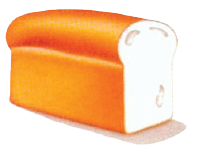
Possible Causes
Old Dough
Follow proper fermentation time.
Overproofing
Large cells are created. Check proofing time.
Improper Mixing
Overmixing weakens the dough and undermixing
underdevelops the dough; each causes poor gas retention.
Mix to proper dough development.
Excess Dusting Flour
Flour won’t dispense properly, becoming trapped and creating holes. Minimize dusting flour.
Lack of Moisture in Proofer
Dough forms a crust, trapping gas. Adjust proofer
to proper humidity.
Excess Divider Oil
Oil ends up in dough’s interior and cells can’t support it, causing holes. Minimize divider oil.
Lack of Moisture in Proofer
Dough forms a crust, trapping gas. Adjust proofer
to proper humidity.
Excess Divider Oil
Oil ends up in dough’s interior and cells can’t support it, causing holes. Minimize divider oil.
Improper Moulding
Set moulder properly to expel most of the gas.
Insufficient Intermediate Proof
Results in coarse cell structure with holes. Provide proper rest time after dividing and before moulding.
Moulder Rollers in Poor Condition
Trapped gas in dough causes holes. Check and repair moulders for dents, scores or holes.
Dough Too Stiff
Dough won’t achieve proper cell structure, resulting in holes. Follow formula water level.
Humidity Too High in Proofer
A tough crust is formed while baking, creating small holes underneath crust.
Cool Oven
Dough will rise too much in oven before yeast is killed, causing holes.
Proofer Temperature Too High
Dough ferments too quickly, contributing to holes. Adjust to proper proofer temperature.
Rough Handling at/in Oven
Cell structure will collapse and not fully recover. Handle with care.
Hollow Bottom
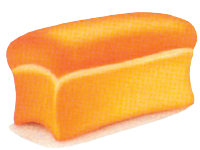
Possible Causes
Overmixing
Overmixing weakens the dough, causing poor gas retention. Mix to proper dough development.
Proofer Humidity Too High
Too much steam will make dough flow, causing lack of gas retention. Adjust to proper humidity.
Moisture in Bottom of Pans
Dry pans thoroughly before use.
Underscaling
Bread will not have enough body. Cell structure will be open, allowing heat to penetrate further than normal.
Use proper amount of dough for pan size.
Use of Hot Pans
Pans should be at room temperature.
Lack of Volume
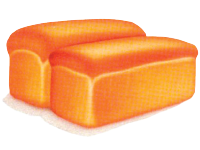
Possible Causes
Insufficient Yeast
Causes lack of dough maturity. Follow recommended yeast levels.
Dough Too Soft/Stiff
A soft dough requires longer mixing, causing lack of gas retention. A stiff dough won’t allow for proper expansion. Follow formula water level.
Old Dough
Follow proper fermentation time.
Frozen, Old or Hot Yeast
Stressed yeast causes poor gas production. Keep
compressed yeast refrigerated and check freshness.
Instant yeast has a shelf life of 1 year without
refrigeration, as long as vacuum is not broken.
Insufficient Intermediate Proof
Dough will lack maturity. Provide proper rest time after mixing and before moulding.
Use of Hot/Cold Pans
Both will slow proofing down. Pans should be at room temperature
Underproofing
Bread will not have proper volume due to dense crumb. Allow for proper proofing time.
Lack of Moisture in Proofer
There should be enough humidity in proofer to prevent skinning of dough.
Improper Mixing
Overmixing weakens the dough and undermixing underdevelops the dough; each causes poor gas retention. Mix to proper dough development.
Proofer Too Hot
High temperature will kill some of the yeast, weakening the dough. Adjust to proper temperature.
Oven Too Hot
This kills yeast too quickly, causing crust to form prematurely.
Proofer Humidity Too High
Too much steam will make dough flow, causing lack of gas retention. Adjust to proper humidity.
Rough Handling at/in Oven
Product will fall and not fully recover. Handle with care.
Overproofing
Product collapses when overproofed. Check proofing time.
Dough Temperature Too Hot/Cold
Hot dough will age too quickly and become weak. Cold dough will not mature properly. Follow proper
dough temperature.
Too Much Volume
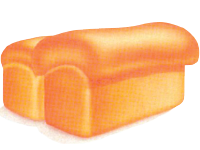
Possible Causes
Overproofing
Creates large cells. Check proofing time.
Improper Moulding
Set moulder properly to expel most of the gas.
Cool Oven
Dough will rise too much in the oven before
yeast is killed. Check oven temperature.
Overscaling
Scale proper dough weight for size of pan used.
Moulder Rejects

Possible Causes
Improper Moulding
Set moulder properly to expel most of the gas.
Dough Too Stiff
Dough won’t achieve proper cell structure. Follow formula water level.
Old Dough
Follow proper fermentation time.
Dirty Moulder
Clean for optimal use.
Sticky Dough
Check water level and mixing time.
Improper Feeding of Moulder
Readjust feeding to correct.
Crust Too Thick

Possible Causes
Cool Oven
Heat will penetrate into crumb further than
normal. Check oven temperature.
Overbaking
Check oven temperature and baking time.
Lack of Moisture in Proofer
There should be enough humidity in proofer to
prevent skinning of dough.
Underscaling
Bread will not have enough body. Cell structure will be open, allowing heat to penetrate further than normal.
Use proper amount of dough for pan size.
Excess Shredding / Capping
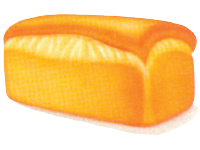
Possible Causes
Dough Too Stiff
Prevents proper expansion, resulting in loaf breaking at
the seam (the weakest point). Follow formula water level.
Underproofing
Proper volume has not been achieved, causing quick
rise in oven. Check oven temperature.
Young Dough
A tight cell structure has a tendency to shred.
Allow for proper fermentation time.
Improper Panning
Dough must be placed in pan seam-side-down.
Poorly Shaped Loaf
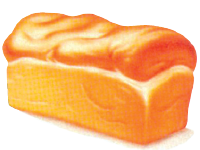
Possible Causes
Improper Moulding
Set moulder properly to expel most of the gas.
Overscaling
Scale proper dough weight for size of pan used.
Improper Panning
Dough must be placed in pan seam-side-down.
Overproofing
Product collapses when overproofed.
Check proofing time.
Rough Handling
Cell structure will collapse and not fully recover.
Handle with care.
Flat Top / Sharp Corners

Possible Causes
Overmixing
Overmixing weakens the dough, causing poor gas
retention. Mix to proper dough development.
Proofer Humidity Too High
Too much steam will make dough flow, causing lack
of gas retention. Adjust to proper humidity.
Very Soft Dough
Causes poor gas retention. Follow formula water level.
Young Dough
Dough will not retain all gas produced. Allow for
proper fermentation time..
Loaf Bursts on the Side

Possible Causes
Overmixing
Overmixing weakens the dough, causing poor gas
retention. Mix to proper dough development.
Underproofing
Proper volume has not been achieved, causing quick
rise in oven. Allow for proper proofing time.
Improper Moulding
Set moulder properly to expel most of the gas.
Oven Too Hot
Premature crust formation can cause loaf to burst.
Check oven temperature.
Crust Too Dark

Possible Causes
Oven Too Hot
Follow proper oven temperature.
Too Much Sugar
Minimize sugar in formula.
Overbaking
Check oven temperature and baking time.
Crust Too Pale
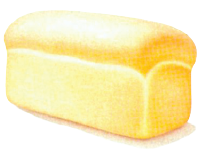
Possible Causes
Old Dough
Sugars are consumed by yeast, resulting in almost
no browning. Follow proper fermentation time.
Underbaking
Check oven temperature and baking time.
Cool Oven
Prevents proper browning. Check oven temperature.
Bread Caves In
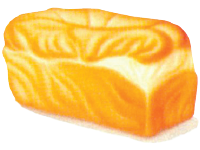
Possible Causes
Underbaking
Check oven temperature and baking time.
Old Dough
Follow proper fermentation time.
Pans Too Close Together
Space pans properly.
Overproofing
Product collapses when overproofed. Check
proofing time.
Pans Greased Too Heavily
Use grease sparingly.
Irregular Slices

Possible Causes
Underbaking
Check oven temperature and baking time.
Slicer Blades Dull/Guides Not Set Properly
Check and maintain equipment for proper use.
Bread Too Warm for Slicing
Internal temperature of loaf should reach
95°F/35°C or less.
Blisters on Crust

Possible Causes
Young Dough
Dough won’t retain all gas produced. Some escaping gas
gets trapped at surface, forming blisters. Allow for proper
fermentation time.
Rough Handling at/in Oven
Product will fall and not fully recover. Handle with care.
Improper Mixing
Overmixing weakens the dough and undermixing
underdevelops the dough; each causes poor gas retention.
Mix to proper dough development.
Improper Moulding
Set moulder properly to expel most of the gas.
Proofer Humidity Too High
A tough crust is formed while baking, creating small
holes underneath the crust.
Very Soft Dough
Causes poor gas retention. Follow formula water level.
Moldy Bread
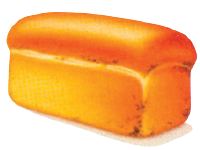
Possible Causes
Bread Wrapped Too Hot
Causes condensation to form. Internal temperature of
loaf should reach 95°F/35°C, which usually takes 2-3
hours at room temperature.
Contaminated Wrappers
Keep unused packaging stored in a sealed,
clean environment.
Product Contact with Unsanitary Equipment
Clean areas in contact with finished product and wash
down with food grade sanitizer.
Underscaling
Bread will not have enough body. Cell structure will be open, allowing heat to penetrate further than normal.
Use proper amount of dough for pan size.
Bread Exposed to Dust
Keep work and display environments clean.
Poor Flavor
Possible Causes
Old Dough
Causes acids to be produced, changing the flavor.
Follow proper fermentation time.
Overproofing
Causes excessive acid development.
Check proofing time.
Improper Mixing
An undermixed dough has a raw dough flavor.
Follow proper mixing directions.
Product Contact with Unsanitary Equipment
Clean areas in contact with finished product and
wash down with food grade sanitizer.
Underbaking
Proper crust formation will not occur, resulting in
a raw dough of yeasty flavor. Check oven temperature
and baking time.
Careless Lubricating of Equipment
Maintain equipment with cleanliness and precision.
Improper Storage of Flour
Store flour away from highly odorous products
such as soap or solvents.
Baked Products Stale
Know the shelf life of the finished product.
Baked Products Moldy
Dispose of product and sanitize preparation and
display areas with food grade sanitizer.
Poor Keeping Qualities
Possible Causes
Old Dough
Open grain allows moisture to escape. Follow proper
fermentation time.
Proofer Too Hot
Causes product to develop a coarse texture.
Check proofer temperature.
Improper Mixing
A properly developed dough contributes to good
cell structure, which retains moisture. Follow proper
mixing directions.
Cool Oven
Slows down crust formation, resulting in high
moisture loss. Check oven temperature.
High Dough Temperature
Temperature should be between 75°-82°F/24°-28°C
to reduce staling.
Overbaking
Creates excessive moisture loss. Check oven
temperature and baking time.
Underscaling
Causes grain to open, resulting in increased moisture loss.
Use proper amount of dough for pan size.
Bread Wrapped Too Hot/Cool
If wrapped too hot, condensation forms; if too
cool, bread will begin to stale. Internal temperature
of loaf should reach 95°F/35°C, which usually takes
2-3 hours at room temperature.
Improper Amount of Shortening
Check recipe for proper amount.
